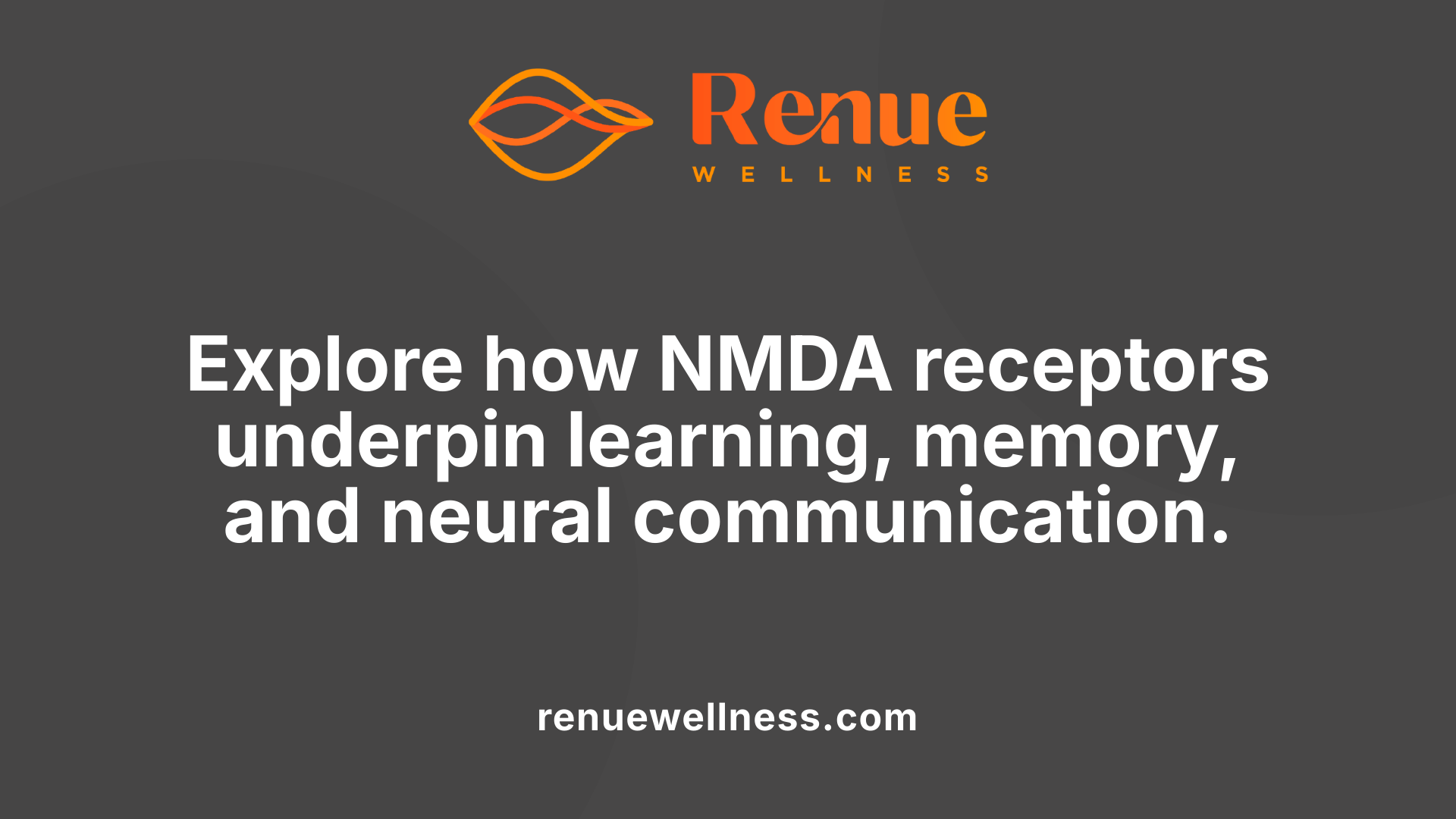The Connection Between Trauma, Memory, and NMDA Receptors


August 12, 2025
Understanding the Neurobiology of Trauma and Memory
The intricate relationship between trauma, memory, and neurobiological mechanisms is a central focus in neuroscience research. Among various molecular players, NMDA receptors (NMDARs) stand out as crucial mediators of synaptic plasticity, learning, and memory. This article explores how trauma impacts NMDAR functioning, the subsequent effects on neuronal and network properties, and the promising therapeutic avenues targeting these receptors.
Fundamental Role of NMDA Receptors in Brain Function

What do NMDA receptors do in the brain?
NMDA receptors are a specialized type of glutamate receptor and ion channel found on nerve cells. They serve as the brain's primary excitatory neurotransmitter receptors and are crucial for rapid signal transmission in the nervous system.
These receptors are essential for synaptic plasticity, such as long-term potentiation (LTP) and long-term depression (LTD), which are cellular mechanisms underlying learning and memory. Activation of NMDA receptors involves the binding of glutamate and a co-agonist like glycine or D-serine. They are unique because their activity depends on both ligand binding and postsynaptic depolarization, which removes a magnesium or zinc block from the pore.
Overactivation of NMDA receptors can lead to excessive calcium influx, causing excitotoxicity—a process implicated in neurodegenerative diseases like Alzheimer's, stroke, and epilepsy. Dysfunction of these receptors, including autoantibody targeting, is linked to various neurological and psychiatric disorders, such as schizophrenia, depression, and autoimmune encephalitis. Because of their pivotal role in neural signaling and disease, NMDA receptors are significant targets for therapeutic intervention.
What is the role of NMDA in trauma, memory, and neuroplasticity?
NMDA receptors are central players in neuroplasticity—the brain’s ability to reorganize itself by forming new neural connections. They facilitate synaptic modifications critical for learning and memory by regulating calcium entry into neurons.
During learning processes, NMDA receptor activation leads to steady increases in synaptic strength via LTP, as well as weakening of connections through LTD. These processes are dependent on the precise regulation of calcium influx, which triggers signaling cascades that alter gene expression and synaptic structure.
Following traumatic brain injury (TBI), NMDA receptor dysfunction or excessive activation can cause neuronal damage through excitotoxicity. The influx of calcium overloads neurons and initiates cell death pathways, contributing to cognitive deficits and chronic neurological conditions.
In development, NMDA receptors contribute to the maturation of synaptic circuits, influencing neuroplasticity across the lifespan. Their activity impacts structural plasticity by promoting dendritic growth and spine formation.
Dysregulation of NMDA receptor activity, whether through genetic mutations, biochemical imbalance, or environmental trauma, can exacerbate brain damage and impair recovery processes. For example, increased activity of specific subtypes such as GluN2B is associated with excitotoxicity, while others like GluN2A tend to promote neuroprotection.
In sum, NMDA receptors’ role in trauma, memory, and neuroplasticity underscores their importance as both facilitators of healthy brain function and as points of vulnerability in brain injury and neurodegenerative diseases.
Impact of Trauma on NMDA Receptor Activity and Neuronal Properties

How does trauma, including traumatic brain injury, influence NMDA receptor activity and neuronal properties?
Trauma, especially traumatic brain injury (TBI), has profound effects on NMDA receptor (NMDAR) function and neuronal characteristics. During injury, mechanical forces can cause a partial loss of the typical magnesium (Mg2+) block that normally regulates NMDAR activity. This reduction in Mg2+ block results in heightened channel opening and excessive calcium (Ca2+) influx, which increases neuronal excitability.
Molecular changes accompany these functional shifts. A notable alteration includes the increased expression and activation of GluN2B-containing NMDARs, predominantly located extrasynaptically. These subunits have longer open times, contributing to sustained calcium entry and excitotoxic stress. Such shifts in subunit composition decrease the ratio of GluN2A to GluN2B, further disrupting normal receptor dynamics.
Structural damage also arises from these modifications. The elevated calcium levels trigger inflammatory responses and activate enzymes like calpain, which degrade crucial cellular components. This cascade results in structural degeneration, disrupting synaptic architecture and impairing neural circuitry. As a consequence, there is a notable impairment in synaptic plasticity, including processes essential for learning and memory, which become dysfunctional post-injury.
Furthermore, trauma-induced excitotoxicity and associated neuroinflammation lead to neuronal death and microstructural disintegration. These changes alter the intrinsic properties of neurons, reducing their ability to form and maintain effective connections within networks. Ultimately, the altered NMDAR activity and neuronal properties contribute to long-term deficits in cognition, memory, and network stability, characteristic of TBI pathology.
What are the consequences of NMDA receptor overactivation in trauma?
When NMDARs become overactivated following trauma, the consequences are severe and widespread. Excessive calcium entry into neurons initiates a cascade of damaging processes. Calcium overload triggers oxidative stress through the generation of reactive oxygen species (ROS) and activates damaging enzymes like calpain and phospholipases.
This cascade leads to cellular components' degradation, mitochondria dysfunction, and eventually, neuronal apoptosis or necrosis. The region-specific overactivation—particularly at extrasynaptic sites rich in GluN2B subunits—is closely linked to excitotoxic cell death.
The toxic effects of overactivation also result in synaptic loss and network disintegration. These structural and functional disruptions are a core part of secondary injury mechanisms that follow trauma, exacerbating neural network impairment.
Moreover, persistent NMDAR overactivity alters neural circuit dynamics. It can lead to increased uncorrelated activity and disrupt the balance between excitation and inhibition within neural networks. Such dysregulation hampers recovery processes, including neuroplasticity and network rewiring essential for functional restitution.
Clinically, this cascade contributes to cognitive deficits, memory impairments, and behavioral disturbances observed in TBI patients. Understanding these processes underscores the importance of targeted modulation of NMDAR activity in therapeutic interventions to mitigate neuronal damage and enhance recovery efforts.
Subtypes and Modulation of NMDA Receptors in Trauma and Neuroplasticity

What is the involvement of NMDA receptor subtypes and modulation in trauma, memory formation, and neuropsychiatric disorders such as PTSD?
NMDA receptor (NMDAR) subtypes, especially those containing GluN2A and GluN2B subunits, are central to neural processes that underpin learning, memory, and response to trauma. These receptors facilitate synaptic plasticity by regulating calcium influx, which activates signaling pathways critical for strengthening or weakening synaptic connections.
In trauma-related conditions like PTSD, the balance between NMDAR-mediated plasticity and excitotoxicity is disturbed. GluN2B-containing NMDARs are particularly involved in fear extinction and reduction of spontaneous fear recovery. These receptors help promote adaptive responses by enabling neural circuits to modify fear memories. Maladaptive regulation, however, can impair extinction processes, leading to persistent traumatic memories.
Pharmacological modulation, such as using GluN2B-specific agents or partial agonists like D-cycloserine, has shown promise in enhancing fear extinction and reducing trauma-related symptoms. For example, NYX-783, a positive NMDAR modulator targeting GluN2B subunits, has been effective in animal models of PTSD, decreasing spontaneous recovery of fear responses. These findings suggest that targeted modulation of NMDAR subtypes could provide therapeutic avenues for trauma and neuropsychiatric disorders.
Overall, the precise regulation of NMDAR activity via its subtypes significantly influences the formation and extinction of traumatic memories, making it a promising focus for research and treatment strategies.
How does the subunit composition affect the biophysical properties and localization of NMDA receptors?
The composition of NMDA receptor subunits directly impacts their function, trafficking, and distribution within neurons. NMDARs are heterotetramers composed of GluN1 and various GluN2 (A-D) subunits. GluN2A and GluN2B are the most prominent in the cortex and hippocampus, where they have distinct roles in neuronal signaling.
GluN2A-containing NMDARs are predominantly located at synaptic sites. They exhibit faster decay kinetics and are associated with neuroprotective signaling pathways that favor synaptic strengthening such as long-term potentiation (LTP). In contrast, GluN2B-containing NMDARs are often found outside synapses (extrasynaptic) and display slower kinetics, contributing to pathways linked with excitotoxicity and neuronal damage.
The distribution of these subunits affects how neurons respond to stimuli. GluN2A’s synaptic presence supports healthy plasticity and development, while GluN2B’s extrasynaptic localization can lead to activity-dependent neurodegeneration when dysregulated. This subunit-specific localization and function are crucial in determining the outcome of neural responses to injury and neurodegeneration.
Understanding these differences helps to develop targeted treatments that either promote beneficial plasticity or prevent excitotoxic damage, especially in trauma and neurodegenerative diseases.
| Aspect | GluN2A | GluN2B | Implications |
|---|---|---|---|
| Localization | Mainly synaptic | Mainly extrasynaptic | Determines whether NMDAR activity triggers protective or damaging pathways |
| Kinetics | Faster decay | Slower decay | Influences the timing of calcium signaling |
| Signaling | Promotes neuroprotection and plasticity | Associated with excitotoxicity and apoptosis | Critical for therapeutic targeting in trauma and neurodegeneration |
| Role in plasticity | Facilitates LTP and memory formation | Involved in plasticity but also in neuronal damage if overactivated | Modulation can enhance recovery or prevent damage |
Advances in understanding subunit roles continue to shape strategies for managing trauma and neurodegenerative conditions, emphasizing the importance of precise receptor targeting.
Therapeutic Strategies Targeting NMDA Receptors for Trauma and Memory Disorders

Are there potential therapies targeting NMDA receptors for trauma-related memory impairments and neuropsychiatric conditions?
Yes, numerous therapies focus on modulating NMDA receptor activity to address trauma-related memory problems and mental health disorders. Researchers are actively exploring drugs that either inhibit or enhance NMDA receptor function.
For example, NMDA receptor antagonists like ketamine have demonstrated rapid antidepressant effects, making them promising for conditions such as severe depression and PTSD. They help by dampening overactive NMDA signaling, which is often involved in neurotoxicity and mood disturbances.
Conversely, agents that positively modulate NMDA receptors, including drugs that target specific receptor subunits, are under investigation to boost NMDA activity where it is deficient, such as in schizophrenia or cognitive impairments.
Targeting specific subunits, such as GluN2A or GluN2B, can offer more precise therapeutic effects. This approach aims to stimulate beneficial signaling pathways while minimizing excitotoxicity.
Overall, the ability to finely tune NMDA receptor activity holds significant promise. It could lead to treatments that improve memory, reduce trauma re-experiencing, and alleviate symptoms in a variety of neuropsychiatric conditions.
How does the molecule NYX-783 influence fear extinction via NMDA receptor modulation?
NYX-783 is a new type of drug called a positive allosteric modulator of NMDA receptors. It enhances the receptor's response to glutamate, especially at GluN2B-containing NMDA receptors involved in memory processes.
In rodent studies, NYX-783 markedly reduced the spontaneous recovery of fear, a model for persistent traumatic memories like those seen in PTSD. It increased NMDA-induced currents in neurons of the infralimbic medial prefrontal cortex (IL mPFC), an area vital for fear extinction.
Further experiments showed that blocking GluN2B subunits prevented NYX-783 from exerting its effects, pinpointing the importance of GluN2B in fear extinction. Additionally, increased BDNF levels following extinction training suggest that NYX-783 boosts neuroplasticity.
This evidence supports the idea that drugs like NYX-783 can facilitate extinction of traumatic memories by selectively enhancing NMDA receptor activity, especially at GluN2B sites.
Can preconditioning strategies involving NMDA receptor activity offer neuroprotection against trauma-related damage?
Absolutely. NMDA preconditioning involves administering low doses of NMDA to activate the receptor mildly, which in turn triggers protective cellular mechanisms.
In models of traumatic brain injury (TBI), such preconditioning has been shown to preserve hippocampal neurons, preventing the typical damage caused by excitotoxicity. It primes neurons to withstand subsequent stress, thus reducing neuron death and preserving cognitive functions.
This approach leverages the brain’s natural adaptive responses. By inducing a state of tolerance, NMDA preconditioning can mitigate the damaging effects of more severe excitotoxic events following TBI.
While promising in animal studies, translating this into clinical practice requires further research. However, these findings highlight an innovative strategy: controlled activation of NMDA receptors could serve as a neuroprotective tool against injuries like TBI.
| Therapeutic Strategy | Target/Receptor | Effect | Additional Details |
|---|---|---|---|
| NMDA receptor antagonists | NMDA receptors | Reduce excitotoxicity | Includes ketamine, memantine |
| GluN2B-positive modulators | GluN2B subunits | Enhance fear extinction | NYX-783 as a neuroplasticity enhancer |
| NMDA preconditioning | NMDA receptor activity | Neuroprotection | Low-dose activation induces tolerance |
This array of approaches points toward personalized and phase-specific treatments, aiming to balance NMDA activity for optimal neural health and recovery.
Neural Circuit Changes Post-Trauma and Their Implications

What are the effects of trauma on neural circuit activity and connectivity?
Trauma, such as traumatic brain injury (TBI), induces complex alterations in neural circuit activity and connectivity. These changes are characterized by an overall increase in uncorrelated network activity and a disruption in normal connectivity patterns. One of the primary mechanisms involves modifications in NMDA receptor (NMDAR) function, especially the interactions involving the GluN2B subunit. Post-injury, neurons heavily reliant on GluN2B-mediated calcium influx tend to lose many of their functional targets, which leads to a breakdown in network integrity.
This disconnect hampers the brain's ability to undergo plastic changes and adapt, impairing processes like learning and memory. Meanwhile, neurons with substantial GluN2A contributions or those with high degrees of functional connectivity display a resilience to injury-induced connectivity loss. This differential vulnerability suggests some pathways remain more intact, providing potential avenues for targeted therapies.
Manipulating NMDARs—either by enhancing their mechanosensitivity or modulating GluN2B signaling—can influence how networks reorganize after trauma. Such interventions could promote adaptive plasticity, aid in recovery, or even prevent maladaptive reorganization that impairs cognitive functions.
Understanding these detailed network dynamics helps us appreciate why trauma results in persistent cognitive and behavioral deficits and provides insight into how to develop interventions to restore neural circuit functionality.
How does calcium influx through NMDARs affect neuronal network reorganization after injury?
Calcium entry through NMDA receptors plays a pivotal role in synaptic plasticity and the reorganization of neural networks following injury. Normally, NMDAR-mediated calcium influx supports the strengthening or weakening of synapses through processes like long-term potentiation (LTP) and long-term depression (LTD). After trauma, however, the pattern and amount of calcium influx are altered.
Specifically, GluN2B-containing NMDARs are highly permeable to calcium and are often overactivated following injury, resulting in excessive calcium entry. This overload can trigger detrimental cascades, including the activation of enzymes that degrade essential cellular components, production of reactive oxygen species (ROS), and initiation of inflammatory responses. These processes contribute to neuronal damage and the loss of functional connectivity within neural circuits.
Consequently, this maladaptive calcium signaling impairs the brain's capacity for proper network remodeling, which is vital for recovery. Modulating calcium influx—either by selectively blocking GluN2B-containing NMDARs or fine-tuning receptor activity—has shown promise in reducing damage and supporting healthy network reorganization.
Strategically targeting NMDAR pathways to control calcium influx thus stands as a potential therapeutic strategy to promote adaptive neuroplasticity and functional recovery after neural trauma.
| Aspect | Impact | Mechanism | Potential Intervention |
|---|---|---|---|
| Increased calcium influx | Neuronal damage, impaired plasticity | Overactivation of GluN2B NMDARs leads to calcium overload | GluN2B antagonists, receptor modulators |
| Normal calcium signaling | Synaptic plasticity, learning | Balance between GluN2A and GluN2B activity | Receptor subtype-specific treatments |
| Excessive calcium | Cell death, inflammation | Activation of destructive enzymatic pathways | Calcium influx modulation, neuroprotective agents |
Effects of NMDA Receptor Manipulation on Network and Memory Functions
What are the effects of stimulating NMDA receptors after injury?
Stimulation of NMDA receptors during the subacute phase following traumatic brain injury (TBI) has been found to support recovery by enhancing neural plasticity and re-establishment of damaged networks. Administering NMDA agonists in this window can reduce neurological deficits, improve recognition memory, and facilitate the repair of injured neuronal circuits. These effects are primarily due to increased calcium influx through NMDAR channels, which promotes synaptic strengthening, cellular survival, and network remodelling.
Research indicates that timely activation of NMDARs supports cellular mechanisms essential for recovery, such as receptor trafficking and receptor-mediated signaling pathways. Controlled NMDA receptor stimulation also appears to activate neuroprotective processes, reducing the extent of cell death caused by excitotoxicity. Conversely, inhibiting NMDAR activity during this critical period with antagonists like MK801 can hinder recovery, exacerbate deficits, and impair memory functions, emphasizing the importance of precise therapeutic timing.
In summary, careful stimulation of NMDARs after injury fosters neural repair, memory restoration, and functional recovery, highlighting their potential as therapeutic targets in post-injury treatment plans.
Trauma, NMDARs, and Long-term Neurodegeneration Linkages
How does trauma connect to neurodegenerative conditions via NMDA receptor pathways?
Trauma, such as mild traumatic brain injury (mTBI) and more severe traumatic brain injuries (TBI), can induce long-lasting changes in NMDA receptor (NMDAR) function. These changes are particularly prominent at extrasynaptic NMDARs that contain the GluN2B subunit. Post-trauma, there is often an increase in GluN2B-containing NMDAR activity, which leads to excessive calcium influx into neurons.
This overactivation triggers a cascade of damaging cellular events, including oxidative stress, mitochondrial dysfunction, and activation of damaging enzymes like calpains and caspases. Over time, such processes contribute to neuronal death and the accumulation of neurotoxic proteins, notably amyloid-beta oligomers. These amyloid-beta peptides can further activate GluN2B receptors, amplifying calcium overload and neuronal stress.
The cumulative effect of these processes is an accelerated progression toward neurodegenerative diseases such as Alzheimer’s. Studies suggest that trauma-induced NMDA receptor dysregulation, especially at extrasynaptic sites, plays a crucial role in this connection. Modulating NMDAR activity, particularly blocking or fine-tuning GluN2B subunit function, presents a promising approach for preventing or slowing neurodegenerative changes following trauma.
What is the role of calcium overload in trauma-linked neurodegeneration?
Calcium overload occurs when overactivated NMDA receptors allow an excessive influx of calcium ions into neurons. This process is central to trauma-associated neurodegeneration. The GluN2B subunit, predominantly found at extrasynaptic NMDARs, is highly permeable to calcium and becomes overactive after trauma.
This surge of calcium initiates a harmful cellular response, including the generation of reactive oxygen species (ROS), mitochondrial impairment, and activation of destructive enzymes. These events compromise neuronal integrity, leading to apoptosis or necrosis. Persistent calcium overload can also disrupt calcium homeostasis, damaging multiple cellular systems and promoting the formation of neurodegenerative hallmarks like amyloid plaques and tau tangles.
Controlling calcium influx through pharmacological agents that target NMDA receptor subtypes, like GluN2B-specific antagonists, or through neuroprotective strategies, could mitigate the progression of trauma-induced neuronal loss. Such interventions aim to preserve neuronal function and prevent the transition to chronic neurodegenerative states.
| Aspect | Effect of Trauma | Underlying Mechanism | Clinical Significance |
|---|---|---|---|
| NMDA receptor dysregulation | Increased GluN2B activity at extrasynaptic sites | Excessive calcium influx, oxidative stress, excitotoxicity | Accelerates neurodegeneration, supports targeted therapies |
| Amyloid-beta accumulation | Enhances GluN2B activation | Amyloid-beta oligomers activate receptors, promoting calcium overload | Contributes to Alzheimer's pathology |
| Calcium overload | Neuronal damage and death | Disrupted calcium homeostasis from NMDAR overactivation | Key target for neuroprotective interventions |
Understanding the detailed pathways connecting trauma, NMDA receptor function, calcium dysregulation, and neurodegenerative processes underscores the importance of precise receptor modulation. Therapeutic strategies focusing on NMDAR subtypes, especially GluN2B, and calcium-dependent pathways hold promise for preventing long-term neuronal decline after trauma.
Neuroprotective Approaches and Future Directions
Can NMDA receptor modulation serve as a neuroprotective strategy for trauma?
Yes, adjusting NMDA receptor activity offers a promising approach for protecting the brain after injury. One method involves receptor preconditioning, where low-dose NMDA stimulation before injury induces cellular tolerance, helping neurons resist damage. Studies show that NMDA preconditioning can preserve hippocampal cell viability and prevent memory deficits following traumatic brain injury (TBI).
Another strategy focuses on receptor antagonists like memantine, which blocks excessive NMDA activation at extrasynaptic sites during overactivation, thereby reducing excitotoxicity without impairing normal physiological signaling. This selective blockade supports neuron survival while maintaining necessary synaptic functions.
Recently, positive modulators such as NYX-783 have demonstrated potential in reducing trauma-related symptoms like fear memory revival. They enhance NMDA receptor activity selectively, improving fear extinction and promoting neural plasticity.
Overall, these approaches aim to restore balance in NMDA receptor function—limiting damaging overactivation while encouraging beneficial plasticity—to support recovery after trauma.
What are promising future therapies based on NMDAR biology?
Future treatments rooted in understanding NMDA receptor mechanisms include highly specific modulators targeting distinct subunits, notably GluN2B. These drugs could mitigate excitotoxicity, often linked to neurodegenerative diseases, and enhance therapeutic outcomes for trauma-related disorders.
For instance, GluN2B antagonists might prevent calcium overload during overactivation, reducing neuronal death after events like stroke or TBI. Conversely, positive allosteric modulators (PAMs) that enhance receptor activity at appropriate times could facilitate processes like memory extinction, crucial in PTSD therapy.
Drugs like xenon, an NMDA antagonist, have shown to influence memory reconsolidation by inhibiting receptor activity during trauma reprocessing. Combined with co-agonists such as D-serine that enhance receptor function, these strategies aim to precisely tune NMDA activity.
Emerging research also focuses on the regulation of receptor trafficking and downstream signaling pathways. By modulating receptor localization—either strengthening synaptic or reducing extrasynaptic activity—therapeutics can better support neural repair.
Overall, the continued development of receptor subtype-specific agents, combined with advances in understanding NMDA receptor regulation, paves the way for innovative therapies for neuroprotection, psychiatric conditions, and trauma recovery.
Summary and Implications for Trauma and Memory Research
What do current research findings imply about the role of NMDA receptors in trauma and memory?
Recent studies highlight the central role of NMDA receptors (NMDARs) in shaping trauma-related neural adaptations, learning, and plasticity processes in the brain. These receptors, particularly through their subunits like GluN2B and GluN2D, are crucial in regulating synaptic responses that underpin memory formation and extinction.
In traumatic brain injury (TBI), NMDAR function often becomes dysregulated. Mild TBI, for example, can induce a partial loss of the magnesium block of NMDARs, resulting in excessive neuronal excitation. This hyperactivity propagates through neural circuits, impacting both injured and uninjured neurons, thereby disrupting network connectivity. The increase in calcium influx through overactive NMDARs, especially at extrasynaptic sites, contributes to excitotoxicity—an underlying mechanism leading to neuronal death and long-term cognitive deficits.
Moreover, in fear and trauma-related contexts, NMDAR activity in specific regions such as the retrosplenial cortex (RSC) and medial prefrontal cortex (mPFC) is vital for memory retrieval and extinction. Pharmacological blockade of NMDARs in these regions impairs the ability to retrieve fear memories without affecting the original memory storage, indicating a specialized role during memory recall. Notably, the NR2A subunit in RSC has been linked to the retrieval process, and interventions targeting this subunit can modulate trauma-related re-experiencing, which is relevant to disorders like PTSD.
Additionally, trauma influences the composition and distribution of NMDAR subunits, with an increase in GluN2B activity following trauma, driving calcium overload and excitotoxic damage. This maladaptation worsens neural circuit stability and may accelerate neurodegenerative processes such as Alzheimer’s disease, especially when combined with amyloid-beta pathology.
Research into therapeutic modulation of NMDARs has yielded promising strategies. Agents like memantine, which preferentially block extrasynaptic NMDARs, help reduce excitotoxicity in neurodegenerative diseases. Conversely, positive modulators like NYX-783 enhance NMDAR signaling, promoting fear extinction and reducing persistent trauma-related memories by acting on GluN2B-containing receptors in the mPFC.
Further, preconditioning with low-dose NMDA can prepare neural tissues against injury-induced cellular damage, offering a neuroprotective approach post-TBI. In animal models, stimulating NMDA receptor activity during a critical window after injury can significantly improve recovery outcomes, challenging earlier approaches that favored receptor blockade.
At the molecular level, NMDARs' heterotetrameric complexes comprising various subunits (GluN1, GluN2A-D, GluN3) shape their biophysical properties, trafficking, and localization, influencing regional and functional differences in neural signaling. For instance, synaptic NMDAR activation promotes neuroprotection and healthy plasticity, whereas extrasynaptic activation often triggers cell death pathways.
What are the therapeutic potentials based on this understanding?
The intricate involvement of NMDARs in trauma and memory points to numerous therapeutic opportunities. Pharmacological agents that fine-tune NMDAR activity can induce beneficial plasticity changes, facilitate fear extinction, and protect against excitotoxic damage.
Positive modulators like NYX-783 demonstrate that enhancing NMDAR function, particularly at GluN2B sites in the mPFC, can reduce trauma-related memories, potentially benefiting conditions like PTSD. Conversely, selective antagonists or partial agonists, such as D-cycloserine, improve extinction learning and are being explored in clinical settings.
Agents like memantine, used in Alzheimer’s disease, exemplify therapeutic strategies aiming to mitigate excitotoxicity by blocking overactive NMDARs at extrasynaptic sites. In the case of TBI, timely stimulation of NMDARs during a subacute phase may promote recovery instead of hindering it.
Additionally, targeting the biochemical pathways regulating NMDAR subunit expression and co-agonist availability, such as d-serine and serine racemase, holds promise for restoring normal receptor function and neuroplasticity.
Directions for future research
Looking ahead, refining receptor-specific pharmacology remains a priority. Developing compounds that selectively modulate synaptic versus extrasynaptic NMDARs can maximize therapeutic benefits while minimizing toxicity. Investigating the timing and dosage of interventions—whether augmentation or inhibition—will be critical for translating preclinical successes into clinical treatments.
Further understanding the role of NMDAR subunits like GluN2D in extinction and plasticity could unlock new strategies for fear reduction therapies. The genetic and epigenetic regulation of NMDAR subunit expression warrants exploration, potentially enabling personalized treatments tailored to individual neurochemical profiles.
Finally, integrating advanced imaging and electrophysiological techniques will be vital for elucidating real-time receptor activity changes during trauma and recovery. Such insights will facilitate the development of predictive biomarkers and targeted interventions, ultimately improving outcomes for trauma survivors and individuals with neurodegenerative or mood disorders.
Insights into the Long-Term Trajectory of Trauma-Related Brain Changes
How do NMDA receptor alterations persist long-term after trauma, and what does this imply for recovery?
Trauma, such as mild traumatic brain injury (mTBI), induces lasting changes in NMDA receptor (NMDAR) expression and subunit composition. Notably, there is often an increase in GluN2B-containing NMDAR activity, particularly at extrasynaptic sites. This overactivation persists long after the initial injury, contributing to disrupted calcium homeostasis within neurons.
Prolonged receptor dysregulation leads to sustained calcium overload, which can trigger excitotoxic pathways, neuronal death, and impairment of neural network connections. These long-term alterations hinder the brain's capacity to recover memories, learn new information, and maintain healthy synaptic plasticity.
The imbalance created by persistent receptor changes impacts not only individual neurons but also the overall network dynamics. Neural circuits become hyperactive or uncoordinated, which can promote neurodegenerative processes and exacerbate cognitive deficits.
Despite these challenges, the brain exhibits some capacity for recovery through mechanisms like network rewiring, receptor replacement, and synaptic plasticity. These processes involve the formation of new connections and the re-establishment of functional circuits over days to weeks post-injury.
Research suggests that targeted interventions during critical windows after trauma—such as pharmacological modulation of NMDAR activity—could enhance these recovery processes. For example, using NMDAR antagonists or positive modulators like NYX-783 may promote the normalization of network activity and facilitate memory recovery.
However, understanding the long-term effects of trauma on NMDAR-related pathways remains complex. Continued investigation into how receptor expression evolves over time and interacts with network plasticity is crucial. Such insights could lead to more effective therapies aimed at mitigating the lasting impacts of brain injuries and improving recovery outcomes.
Bridging Research and Clinical Practice
Understanding the multifaceted roles of NMDA receptors in trauma, memory, and neural plasticity offers invaluable insights for developing targeted therapies. As ongoing debates highlight complex receptor dynamics, a nuanced approach to modulating these receptors holds promise for enhancing neuroprotection and facilitating recovery from trauma-related impairments. Advancing our knowledge in this field will continue to shape innovative solutions, transforming trauma care and neuropsychiatric treatment landscapes.
References
- NMDA receptor alterations after mild traumatic brain injury induce ...
- Role of NMDA Receptor-Mediated Glutamatergic Signaling in ...
- NMDA Receptors in Retrosplenial Cortex Are Necessary for ...
- d-Serine as the gatekeeper of NMDA receptor activity - Nature
- Controversial findings on the role of NMDA receptors in traumatic ...
- Positive modulation of N-methyl-D-aspartate receptors in the mPFC ...
- NMDA preconditioning prevents object recognition memory ...
- Single-Neuron NMDA Receptor Phenotype Influences Neuronal ...
- Dynamic changes in N-methyl-d-aspartate receptors after closed ...
- NMDA Receptor: Function, Addiction Impact, and Recovery
Recent Posts
Conditions Treated
AnxietyDepressionOCDPTSDPostpartum DepressionPain ManagementSubstance AbuseSuicidal IdeationOur Location


